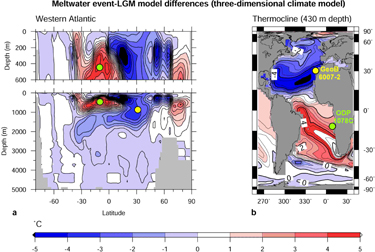|
Detecting Holocene changes in the Atlantic Meridional Overturning Circulation: Integration of Proxy Data and Climate Simulations
Principal Investigators: Carsten Rühlemann (BGR Hannover),
Stefan Mulitza (University of Bremen), André Paul (University of Bremen), Michael Schulz (University of Bremen)
Project Scientists: Audrey Bamberg (University of Bremen), David Heslop (University of Bremen), Helge Meggers (University of Bremen), Tim Freudenthal (University of Bremen)
Response of the Atlantic Ocean to a meltwater perturbation of 0.5 SV over 500 years: (a) zonally averaged temperature change at year 500 (end of meltwater perturbation) relative to the unperturbed equilibrium state for glacial boundary conditions; (b) same as in (a) but shown for the 430 m depth level (the water depth of core ODP 1078C). Contour interval is 0.5°C; red colors indicate warming, blue colors represent cooling. Sites of sediment cores selected for the proposed study are indicated by yellow and green dots.
The Atlantic Meridional Overturning Circulation (MOC) carries warm water northward in surface layers with compensating southward flow at depth. Associated with this overturning is a northward heat transport. It is widely (though not universally) accepted that this heat transport makes a substantial contribution to the moderate climate of maritime and continental Europe, and that any slowdown in the overturning circulation has a profound impact on global climate. In this proposal we focus on reconstructing and modeling anomaly patterns of temperature, radiocarbon concentration (δ14C), and stable oxygen and carbon isotope ratios in tropical/subtropical upper ocean waters of the Atlantic for rapid climate events during the past 15,000 years that are evidently related to reduced MOC: the Younger Dryas cold period and the so-called “8.2-kyr” and “4.2-kyr” events. Especially the 8.2-kyr event which occurred under near-modern climate conditions will help in estimating limits on climate anomalies that might result from a possible future slowdown of the Atlantic MOC in response to continued global warming and an intensification of the hydrological cycle. Moreover we plan to determine the decadal-to-centennial-scale variability of upper ocean water properties. The DAMOCLES project will combine paleo-proxy data with climate model studies in order to advance our understanding with regard to those key questions formulated in the INTERDYNAMIC proposal that address: (1) amplitudes of natural Holocene climate variability, (2) temporal and spatial changes in patterns of climate variability, and (3) abrupt shifts in the Atlantic large-scale ocean circulation during interglacials.
Quantitative paleo-temperature reconstructions, surface-to-intermediate water radiocarbon gradients, coupled climate modelling
Archives
Marine records from the tropical/subtropical Atlantic
|
| < Prev | Next > |
|---|


